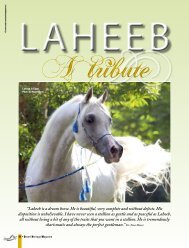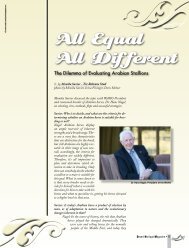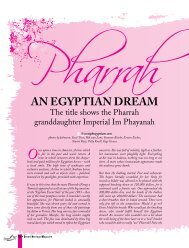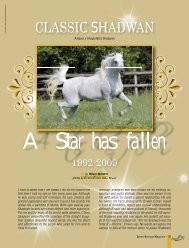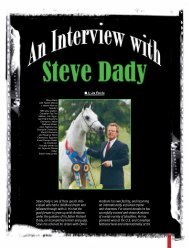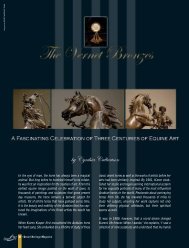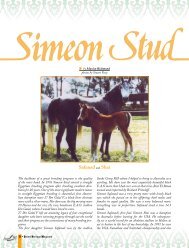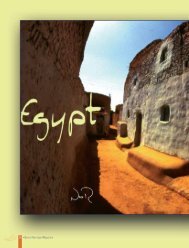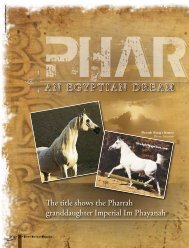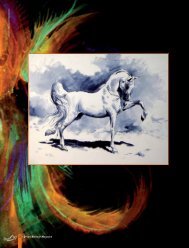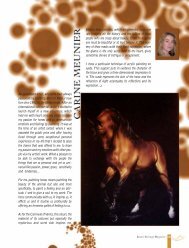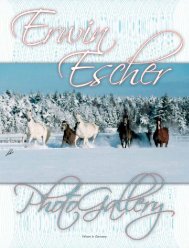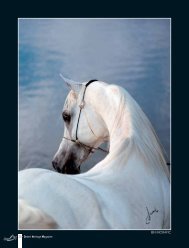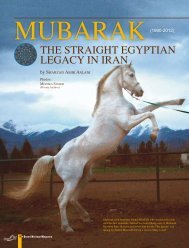Bint Maisa El Saghira - Desertheritagemagazine.com desert ...
Bint Maisa El Saghira - Desertheritagemagazine.com desert ...
Bint Maisa El Saghira - Desertheritagemagazine.com desert ...
Create successful ePaper yourself
Turn your PDF publications into a flip-book with our unique Google optimized e-Paper software.
The 1950’s were an interesting period for the Arabian<br />
horse in Egypt. During the early part of the decade the<br />
Royal Agricultural Society (RAS) became the Egyptian<br />
Agricultural Organization (EAO) and the name of the<br />
state stud was changed from Kafr Farouk to <strong>El</strong> Zahraa.<br />
General Tibor Von Szandtner, formerly the head of the<br />
renowned Babolna Stud in Hungary, had <strong>com</strong>e to Egypt in<br />
1949. Shortly thereafter he made the monumental decision<br />
to bring the stallion Nazeer back from one of the many<br />
stallion depots located throughout the country. By the late<br />
1950’s the wisdom of this decision was apparent to all who<br />
traveled down the palm-lined lanes of the EAO. Many<br />
wonderful daughters of this influential stallion were born<br />
during this decade, including Abla, Tifla, *<strong>Bint</strong> Moniet el<br />
Nefous, *<strong>Bint</strong> Nefisaa, *Ansata <strong>Bint</strong> Mabrouka, *Ansata<br />
<strong>Bint</strong> Burka, and *<strong>Bint</strong> Mona, to name just a few. One<br />
leggy Nazeer daughter, a bright bay foaled on August 22,<br />
70 • Desert Heritage Magazine<br />
by Cynthia Culbertson<br />
photos by Judith Forbis, Johnny Johnston, Rhita McNair, Potter,<br />
J. Keeland, Houston, Jerry Sparagowski, Polly Knoll, Robert<br />
Dressler, AM Little, Erwin Escher<br />
1958, was to have a lasting impact in a country far from<br />
her birthplace, and eventually around the world. Her name<br />
was *<strong>Bint</strong> <strong>Maisa</strong> <strong>El</strong> <strong>Saghira</strong>, and she was an unforgettable<br />
mare to all of those who knew her.<br />
“We saw <strong>Bint</strong> <strong>Maisa</strong> <strong>El</strong> <strong>Saghira</strong> as a young mare in<br />
Egypt,” explains Judi Forbis of Ansata Arabian Stud. “She<br />
was among the best of the Nazeer daughters, quite tall and<br />
an elegant individual, although not as exotic in the head as<br />
some of the grey daughters. She had a definite finesse about<br />
her and a quiet self-assurance. Little did we realize that<br />
someday she and *Ansata Ibn Halima would be the two<br />
horses that brought the straight Egyptian into focus in the<br />
American show ring. *<strong>Bint</strong> <strong>Maisa</strong> <strong>El</strong> <strong>Saghira</strong> will always<br />
be one of my favorite Nazeer daughters.”<br />
The journey from Egypt to America was as unforgettable as
*<strong>Bint</strong> <strong>Maisa</strong> <strong>El</strong> <strong>Saghira</strong><br />
*<strong>Bint</strong> <strong>Maisa</strong> <strong>El</strong> <strong>Saghira</strong> (Nazeer x <strong>Maisa</strong>)<br />
was an exceptionally leggy mare who took<br />
the American show ring by storm - winning<br />
fans everywhere for the Egyptian Arabian.<br />
Nazeer<br />
<strong>Maisa</strong><br />
Mansour<br />
<strong>Bint</strong> Samiha<br />
Shahloul<br />
Zareefa<br />
the mare herself. Douglas and Margaret Marshall of<br />
Gleannloch Farms, along with Don and Judi Forbis of<br />
Ansata, and Richard Pritzlaff of Rancho San Ignacio,<br />
were among the first Americans to import Arabians from<br />
the EAO. In those days the horses traveled by boat and the<br />
journey was long and difficult. Sadly, when the three mares<br />
from the first Gleannloch importation arrived in the<br />
United States, they tested positive from a vaccination they<br />
had been given in Egypt and were forced to return once<br />
again by boat. It was only after a second perilous journey<br />
that *<strong>Bint</strong> <strong>Maisa</strong> <strong>El</strong> <strong>Saghira</strong> made it to her final destination<br />
in Texas.<br />
Ironically, her status as an ambassador for the Egyptian<br />
Arabian in America came about because of another tragedy.<br />
*<strong>Bint</strong> <strong>Maisa</strong> <strong>El</strong> <strong>Saghira</strong> had been bred while in Egypt<br />
awaiting her return journey to the U.S., and her foal, by <strong>El</strong><br />
*<strong>Bint</strong> <strong>Maisa</strong> <strong>El</strong> <strong>Saghira</strong> (Nazeer x <strong>Maisa</strong>) demonstrates her<br />
exceptional movement, trademark tail carriage, and the<br />
large nostrils which made her a true "Drinker of the Wind."<br />
*<strong>Bint</strong> <strong>Maisa</strong> <strong>El</strong> <strong>Saghira</strong> winning one of her many English<br />
Pleasure Championships with Rhita McNair aboard. She<br />
was the only mare ever to win U.S. Top Ten Halter, Top Ten<br />
Park and Top Ten English Pleasure.<br />
Sareei was born dead after her arrival. This led to the<br />
landmark decision to put her in training, joining the<br />
famous Gleannloch show string, capably managed by Tom<br />
and Rhita McNair. In many ways, that decision changed<br />
the history of the straight Arabian in the United States.<br />
*<strong>Bint</strong> <strong>Maisa</strong> <strong>El</strong> <strong>Saghira</strong> garnered victory after victory in<br />
both halter and performance. She was named U.S. Top Ten<br />
in Park in 1964 along with the famous Polish import<br />
*Bask. In 1965 she was both a U.S. Top Ten Mare at halter<br />
and U.S. Top Ten in English Pleasure. That same year she<br />
was award the Legion of Merit for her show ring ac<strong>com</strong>plishments<br />
and she remains the only mare to have earned<br />
Top Tens in halter, English Pleasure and Park.<br />
More important than the championship ribbons and<br />
trophies was the impact *<strong>Bint</strong> <strong>Maisa</strong> <strong>El</strong> <strong>Saghira</strong> made on<br />
those who saw her enter the ring. Most people in the<br />
Desert Heritage Magazine • 71
United States were familiar with Egyptian blood primarily<br />
from the imports of W.R. Brown and Henry Babson in<br />
the 1930’s, but they had no idea of the type, elegance and<br />
quality of the horses being bred at the EAO. The reaction<br />
of Melissa Huprich of Lotus Bloodstock is typical of those<br />
who saw this mare in the show ring. “It was an ‘Oh my!’<br />
experience that I have not forgotten for over forty years,”<br />
she explains. “I was at the U.S. Nationals, then held in<br />
Springfield Illinois, and had the opportunity to see *<strong>Bint</strong><br />
<strong>Maisa</strong> <strong>El</strong> <strong>Saghira</strong>, not just showing in the ring, but up<br />
close in her stall. My vision of the Egyptian Arabian to<br />
that point came from the Babson Egyptians, and this mare<br />
was not at all what I had <strong>com</strong>e to expect from them. She<br />
was a lovely mare, but what really surprised me was the<br />
length of leg she had in proportion to her body and size – I<br />
loved this new vision of an Egyptian horse!” Indeed, the<br />
description “New Egyptian” gained popularity to distinguish<br />
these later imports from the older Egyptian bloodlines.<br />
Yet in pedigree, *<strong>Bint</strong> <strong>Maisa</strong> <strong>El</strong> <strong>Saghira</strong> did have a<br />
connection with the Babson Egyptians, as she traced in tail<br />
female to Durra, a Dahmah Shahwaniah mare of the <strong>Bint</strong><br />
el Bahrein branch of this strain, as did *<strong>Bint</strong> <strong>Bint</strong> Durra,<br />
one of the original Babson imports.<br />
As an individual, a characteristic mentioned over and over<br />
when it <strong>com</strong>es to *<strong>Bint</strong> <strong>Maisa</strong> <strong>El</strong> <strong>Saghira</strong> was her length of<br />
leg. “One of my favorite ways of describing *<strong>Bint</strong> <strong>Maisa</strong>’s<br />
conformation is to make reference to her tallness of leg,”<br />
The great sire Nazeer (Mansour x <strong>Bint</strong> Samiha) produced a plethora of great<br />
daughters during the 1950's, many of which went on to stellar careers<br />
as broodmares. (Forbis Photo)<br />
72 • Desert Heritage Magazine<br />
<strong>Maisa</strong>, the dam of *<strong>Bint</strong> <strong>Maisa</strong> <strong>El</strong> <strong>Saghira</strong><br />
was by Shaloul out of Zareefa.<br />
She traced in tail female through Durra<br />
to the <strong>Bint</strong> <strong>El</strong> Bahrein family<br />
of the Dahmah Shahwaniah strain<br />
explains Lisa Lacy, who knew both the mare and many of<br />
her progeny. “She had good length of forearm and fluidity of<br />
movement that made everything she did look effortless. She<br />
seemed to pass along that trait, even with the modifications<br />
from other bloodlines. *<strong>Bint</strong> <strong>Maisa</strong> had a beautiful eye and<br />
refined head but not a particularly dished face.” Today’s<br />
fashion calls for more extremity in the features, but when<br />
one looked at <strong>Bint</strong> <strong>Maisa</strong>, she reflected type and quality,<br />
even without the extreme features. <strong>Bint</strong> <strong>Maisa</strong> had true<br />
balance: her length of neck and body <strong>com</strong>ponents <strong>com</strong>plemented<br />
each other to make her look like a mare with a long<br />
neck, but in fact, her length of leg suggested the length of her<br />
neck and back. <strong>Bint</strong> <strong>Maisa</strong>’s successful performance career<br />
was no accident: she represented form and function at its<br />
finest.”<br />
Steve Diamond, who also spent considerable time with<br />
*<strong>Bint</strong> <strong>Maisa</strong> <strong>El</strong> <strong>Saghira</strong> recalls that while she was full of<br />
grace and elegance, she also had a strong personality.<br />
“When she decided she was not in the mood to do something<br />
it was obvious,” he explains. “She wasn’t afraid of getting<br />
into trouble or being reprimanded, yet when she was happy<br />
and ready to go, she was a tremendous show mare and<br />
nothing could defeat her.”
“*<strong>Bint</strong> <strong>Maisa</strong> <strong>El</strong> <strong>Saghira</strong> and *Ansata Ibn<br />
Halima made a wonderful <strong>com</strong>bination<br />
and won so many friends for the Egyptian<br />
horse on the show circuit,” recalls Judi<br />
Forbis. As they traveled throughout the<br />
U.S. during the show season, the elegant<br />
bay mare and classic grey stallion influenced<br />
countless breeders to add the blood of<br />
the straight Egyptian to their programs.<br />
Yet *<strong>Bint</strong> <strong>Maisa</strong> el <strong>Saghira</strong>’s impact would<br />
go far beyond the show ring as a result of<br />
her years as a broodmare. It was in this<br />
capacity that she would truly influence<br />
Egyptian Arabian breeding around the<br />
world.<br />
Alidaar, another<br />
grandson of *<strong>Bint</strong><br />
<strong>Maisa</strong> <strong>El</strong> <strong>Saghira</strong>, is<br />
a beautiful example<br />
of the quality stallions<br />
which her son<br />
Shaikh Al Badi produced.<br />
Alidaar, who<br />
was exported from<br />
the United States to<br />
France, is now a<br />
senior sire at the<br />
renowned Al<br />
Rayyan Farm of<br />
Qatar.<br />
The beautiful Nafairtiti was the last of three daughters of *<strong>Bint</strong> <strong>Maisa</strong> <strong>El</strong> <strong>Saghira</strong> sired<br />
by the legendary *Morafic.<br />
*<strong>Bint</strong> <strong>Maisa</strong> <strong>El</strong> <strong>Saghira</strong> had nine<br />
living foals, eight of which bred on.<br />
Her first was a filly, Mashallah, by<br />
*Moftakhar. Interestingly, *<strong>Bint</strong><br />
<strong>Maisa</strong> <strong>El</strong> <strong>Saghira</strong> had just been<br />
shown to an English Pleasure<br />
Championship a few short weeks<br />
before she gave birth to her filly<br />
which was born on Christmas Eve.<br />
Next came Dahmah Shahwaniah,<br />
appropriately sired by her <strong>com</strong>panion<br />
on the show circuit, *Ansata<br />
Ibn Halima. “I remember her as<br />
one of the prettiest fillies I saw at<br />
Gleannloch,” recalls Judi Forbis.<br />
Lisa Lacy also loved this beautiful<br />
bay daughter of *<strong>Bint</strong> <strong>Maisa</strong> <strong>El</strong><br />
<strong>Saghira</strong>. “While Dahmah<br />
Shahwaniah had a more <strong>com</strong>pact<br />
frame than her dam, she still had a<br />
vertical look about her, as did her<br />
dam, which was a remarkable and<br />
relatively unique trait of both.”<br />
Dahmah Shahwaniah was a key<br />
broodmare for both Gleannloch<br />
Farms and Bentwood, who purchased<br />
her when she was middleaged.<br />
“When I would walk people<br />
through the pastures at Bentwood,”<br />
Lisa Lacy remembers, “she would<br />
walk up and nudge us with her<br />
Desert Heritage Magazine • 73
nose, and then follow us when we<br />
looked at the other horses. She was just<br />
an ideal <strong>com</strong>bination of sweetness and<br />
spirit and she passed that along to her<br />
foals.”<br />
Dahmah Shahwaniah was an<br />
influential broodmare, producing two<br />
bay stallions for Gleannloch, Shahir by<br />
*Morafic and Almawardy by *Ibn<br />
Hafiza, and another colt by *Ibn<br />
Hafiza, Ibn Dahmahn, after her arrival<br />
at Bentwood. “Both Ibn Dahmahn<br />
and Almawardy reflected the <strong>com</strong>bination<br />
of their sire and dam,” explains<br />
Lisa Lacy, “with a strong croup and<br />
hip, excellent legs, strong shoulder, good<br />
wither and spring of rib, and breathtaking<br />
movement. Ibn Dahmahn was<br />
74 • Desert Heritage Magazine<br />
Ruminaja Ali is perhaps<br />
the most influential of the<br />
grandsons of *<strong>Bint</strong> <strong>Maisa</strong><br />
<strong>El</strong> <strong>Saghira</strong> with a total of<br />
450 foals.<br />
the easiest stallion to ride, handle, breed, or manage in any<br />
way.”<br />
While at Bentwood, Dahmah Shahwaniah also produced<br />
AK Shah Moniet, by *Ibn Moniet <strong>El</strong> Nefous, and AK<br />
Ishmael by her half-brother Shaikh Al Badi, two beautiful<br />
and athletic stallions, both of which were lost at a relatively<br />
young age due to injuries. She also gave birth to the exquisite<br />
AK Nawaal by The Egyptian Prince, a mare that has<br />
carried the banner of the *<strong>Bint</strong> <strong>Maisa</strong> <strong>El</strong> <strong>Saghira</strong> line to<br />
both South America and Europe. AK Nawaal produced<br />
several beautiful offspring for Count Zichy-Thyssen of<br />
Argentina, and then came to Rosemarie Kolster of<br />
Authentic Egyptian Arabians in Germany, where she produced<br />
the beautiful champions Nadirah <strong>El</strong> Shah and<br />
Dahmah Shahwaniah, by *Ansata Ibn<br />
Halima out of *<strong>Bint</strong> <strong>Maisa</strong> <strong>El</strong> <strong>Saghira</strong>,<br />
was admired by all who saw her. She is<br />
also the dam of the beautiful AK Nawaal<br />
by The Egyptian Prince.
Authentic Ibn Nawaal and several other lovely foals which<br />
have bred on in Europe.<br />
Most breeders know that type within a line often differs<br />
considerably according to color and the foals of *<strong>Bint</strong> <strong>Maisa</strong><br />
<strong>El</strong> <strong>Saghira</strong> were no exception. She produced five grey offspring,<br />
three bays, and a single chestnut, her daughter<br />
Dahma Il Ashekwar, sired by the Anter son *Fahidd. This<br />
mare produced two beautiful daughters who also bred on,<br />
Rahmaa and Morgana, both by *Morafic.<br />
In 1968, *<strong>Bint</strong> <strong>Maisa</strong> <strong>El</strong> <strong>Saghira</strong> foaled the first of her five<br />
offspring by the great *Morafic. He was a beautiful colt<br />
named Amaal, which means “hope” and many people considered<br />
him to be her most beautiful son. Although he was<br />
never shown due to an injury as a youngster, Amaal produced<br />
over 150 offspring during his tenure as a sire for<br />
Imperial Egyptian Stud as well as Gleannloch. In many<br />
ways, however, his fame was somewhat eclipsed by the next<br />
*Morafic colt out of *<strong>Bint</strong> <strong>Maisa</strong> <strong>El</strong> <strong>Saghira</strong>, whose name<br />
was Shaikh Al Badi. A U.S. National Futurity Reserve<br />
Champion as a colt, Shaikh Al Badi was also a Class A<br />
Halter Champion and an extremely popular sire. It is<br />
through this sire line that *<strong>Bint</strong> <strong>Maisa</strong> el <strong>Saghira</strong> has made<br />
the greatest impact around the world, and viewing the<br />
numbers associated with Shaikh Al Badi and his popular<br />
sons makes it clear that hers is one of the most influential<br />
dam lines in the straight Egyptian, although, sadly, is relatively<br />
rare in the tail female.<br />
Shaikh Al Badi produced nearly 700 foals and over 4,000<br />
in the second generation. This is largely due to the popularity<br />
of three of his sons who were full brothers out of <strong>Bint</strong><br />
Magidaa: Ruminaja Ali, who sired 450 foals; Ruminaja<br />
Bahjat, whose total is 308; and Alidaar, whose foals number<br />
currently over 200 and who is still siring foals for Al<br />
Rayyan Farm of Qatar. The international influence of<br />
*<strong>Bint</strong> <strong>Maisa</strong> el <strong>Saghira</strong>, although found in the damline<br />
through AK Nawaal, is primarily through these sons of<br />
Shaikh al Badi, whose offspring are found today in almost<br />
every country which breeds straight Egyptians.<br />
Radia, the next foal from *<strong>Bint</strong> <strong>Maisa</strong> <strong>El</strong> <strong>Saghira</strong>, is considered<br />
to be the daughter most like herself, and was a boldmoving<br />
bay mare like her dam. She was retained by<br />
Gleannloch Farms throughout her life and while she died<br />
relatively young, at age twelve, she produced two stallions<br />
and two mares which have bred on in straight Egyptian<br />
lines. Rihahna, the grey full sister to Radia, was <strong>com</strong>pletely<br />
different in type and was an extremely <strong>com</strong>pact, heavierbodied<br />
mare. Rihahna was a Class A Champion mare in<br />
the show ring, and like Radia, was owned by Gleannloch<br />
Farms her entire life. She produced six foals, but only three,<br />
a stallion and two daughters, bred on.<br />
Amaal (*Morafic x *<strong>Bint</strong> <strong>Maisa</strong> <strong>El</strong> <strong>Saghira</strong>) was a stallion<br />
of classical type. He was considered by many to be the<br />
most beautiful son of *<strong>Bint</strong> <strong>Maisa</strong> <strong>El</strong> <strong>Saghira</strong>, and he was<br />
an influential sire for both Gleannloch Farms and<br />
Imperial Egyptian Stud.<br />
Desert Heritage Magazine • 75
Rihahna (*Morafic x *<strong>Bint</strong> <strong>Maisa</strong><br />
<strong>El</strong> <strong>Saghira</strong>) was a Class<br />
Champion at halter for<br />
Gleannloch Farms. She produced<br />
six foals during her lifetime, but<br />
only three have bred on in<br />
straight Egyptian bloodlines.<br />
*<strong>Bint</strong> <strong>Maisa</strong> <strong>El</strong> <strong>Saghira</strong>’s last daughter by *Morafic was<br />
named for an Egyptian queen, Nafairtiti, and was a queen<br />
of a mare herself. She produced twelve foals, ten of which<br />
have contributed to modern straight Egyptian pedigrees.<br />
Nafairtiti spent her final years with Dr. Jody Cruz of<br />
Rancho Bulakenyo, who felt quite privileged to have this<br />
full sister to Shaikh Al Badi. Nafairtiti produced two beautiful<br />
full sisters, Moon Mystique and Kachina Moon by the<br />
*Ansata Ibn Halima son <strong>El</strong> Hilal, and another lovely daughter<br />
Hadassa by The Egyptian Prince. “The Nafairtiti<br />
family represents one of our most successful female lines,”<br />
states Dr. Jody Cruz, “and from this family we have retai-<br />
76 • Desert Heritage Magazine<br />
Shaikh Al Badi, by<br />
*Morafic was the<br />
most famous stallion<br />
out of *<strong>Bint</strong><br />
<strong>Maisa</strong> <strong>El</strong> <strong>Saghira</strong><br />
and was the sire of<br />
nearly 700 foals.<br />
ned SF Moon Maiden, Moon Storm MH,<br />
Kachina MH and Amirah MH. A colt by<br />
Jabbaar <strong>El</strong> Halimaar out of Kachina MH has<br />
just sold to Egypt, so this family will be represented<br />
there as well.”<br />
The last foal from *<strong>Bint</strong> <strong>Maisa</strong> <strong>El</strong> <strong>Saghira</strong> came<br />
when she was seventeen years old. He was a dark<br />
bay colt sired by *Ibn Hafiza named Shamruk.<br />
Steve Diamond recalls being there as *<strong>Bint</strong> <strong>Maisa</strong><br />
<strong>El</strong> <strong>Saghira</strong> gave birth to her final foal. “I watched<br />
Shamruk being born, blew into his nostrils, and<br />
saw him take his first breath. Ironically, I was<br />
also at his side in the year 2000 when Shamruk<br />
took his final breath.” This <strong>com</strong>pact bay stallion,<br />
while he did not have an extreme face, was exceptionally<br />
powerful and correct. “He was extremely<br />
masculine,” recalls Steve Diamond, “with the solid conformation<br />
reminiscent of the Babson Durra line, and he produced<br />
this solid structure in his foals.” Shamruk sired over<br />
140 offspring and the Mantei’s of Canada, who owned<br />
him most of his life, generally used him on their refined<br />
group of heavily Moniet el Nefous bred mares. Shamruk<br />
had an extremely successful show career. He was a multiple<br />
Class A Champion at halter, a Most Classic winner, a<br />
Native Costume winner, and an English Pleasure<br />
Champion, demonstrating the versatility and style of his<br />
famous dam.<br />
Just four short months after giving birth to her last foal,
*<strong>Bint</strong> <strong>Maisa</strong> <strong>El</strong> <strong>Saghira</strong> passed away, yet her legacy in the<br />
world of Arabian horses has given her immortality. Not<br />
only did she inspire hundreds of breeders in her show ring<br />
days, helping create and sustain an awareness of Egyptian<br />
bloodlines, but through her offspring she bequeathed her elegance<br />
and motion to thousands of straight Egyptian<br />
Arabians around the world. In terms of numbers, there is<br />
no doubt that she is one of the most influential Nazeer daughters<br />
in modern pedigrees, as from her nine foals came<br />
1,010 offspring in the second generation alone.<br />
Fate was kind to *<strong>Bint</strong> <strong>Maisa</strong> <strong>El</strong> <strong>Saghira</strong>, despite the bad<br />
luck that plagued her first journey from Egypt. She had<br />
wonderful owners, Doug and Margaret Marshall, and<br />
exceptionally talented trainers, Tom and Rhita McNair.<br />
In her lifetime, *<strong>Bint</strong> <strong>Maisa</strong> <strong>El</strong> <strong>Saghira</strong> gained a legion of<br />
fans, all of which are united in their memories despite the<br />
passing of over forty years – of the beautiful bay Nazeer<br />
daughter they simply say: “She was unforgettable!”<br />
*<strong>Bint</strong> <strong>Maisa</strong> <strong>El</strong> <strong>Saghira</strong><br />
Bay Mare foaled August 22, 1958 at <strong>El</strong> Zahraa in Egypt<br />
Died 26 October 1973 at Gleannloch Farms, Texas, USA<br />
Production Record:<br />
Mashallah, Grey Mare by *Moftakhar, Foaled 24<br />
December 1963<br />
Dahmah Shahwaniah, Bay Mare by *Ansata Ibn Halima,<br />
Foaled 4 February 1966<br />
Dahma Il Ashekwar, Chestnut Mare by *Fahidd, Foaled 3<br />
January 1967<br />
Amaal, Grey Stallion by *Morafic, Foaled 19 January,<br />
1968<br />
Shaikh Al Badi, Grey Stallion by *Morafic, Foaled 17<br />
January 1969<br />
Radia, Bay Mare by *Morafic, Foaled 14 January 1970<br />
Rihahna, Grey Mare by *Morafic, Foaled 16 February<br />
1971<br />
Nafairtiti, Grey Mare by *Morafic, Foaled 01 July 1972<br />
Shamruk, Bay Stallion by *Ibn Hafiza, Foaled 18 June<br />
1973<br />
Radia was one of three *Morafic<br />
daughters from *<strong>Bint</strong> <strong>Maisa</strong> <strong>El</strong><br />
<strong>Saghira</strong> and resembled in dam in<br />
many ways, including her superb<br />
motion<br />
Desert Heritage Magazine • 77



